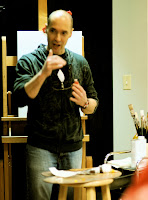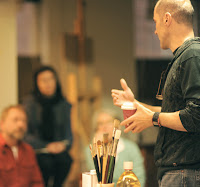Anyone who has worked with Juan Martinez knows that he is an encyclopedia for materials and procedures used by the old masters as well as the best practices used today. He gave us a three hour question and answer period to pick his brain. Here are the highlights of that lecture that stood out for our ARA students:
One point that was helpful to me was that he said house painters need several coats to get the correct tone and color so why should your figure painting's background, shadows, and lights be any different. --Elise Zoller
In the end you'll end up with your own process, materials related. I liked how he showed that he had tested different paints and materials over a long period of time. To work with and really learn any paint, medium, or material takes a great deal of testing and patience. --Liz Beard
I came in late and only saw the end of his demonstration process and I was impressed to see what can be accomplished in just three hours. --Brian Krasinski
I liked that he had a matrix of neutrals showing that varying kinds of neutral colors can be made using different colors of paint. I also liked when he said that the highlight on an object moves with the viewer, while the shadows remain in the same position. --Sean Krajnik
If you stand back and look at your picture you'll see that the shadows appear flat regardless of their level of rendering. Spend more time in the lights, because that is where the viewer sees the real three dimensionality of the form. --Emmy De Musis
If you care about your work you should try to do all of your painting on the best archival practices so that it stands the test of time. --Sarah Bird
As long as it's a good piece of work, someone will find a way to preserve it. --Cindy MacMillan










